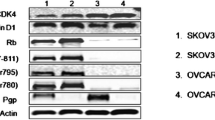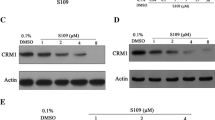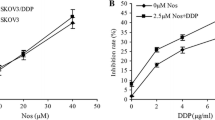Abstract
Background
Epithelial ovarian cancer (EOC) is the most common and lethal ovarian cancer which threatens women health. Nowadays, the standard treatment is maximal cytoreductive surgical debulking followed by chemotherapy. However, immunosuppressive environment generated by chemotherapy, which can be reversed by immunotherapy, leads to the failure of standard treatment. Therefore, a combination of chemotherapy and immunotherapy will be a promising strategy for EOC patients.
Method
For in vitro study, CD73 expression, CD73 activity, and CD8+ T-cell proliferation were measured after docetaxel (DTXL) treatment with or without CD73 antibody. For in vivo study, tumor growth, tumor weight, and the population of various immune cells in the tumor were analyzed in different drug treatment groups.
Results
DTXL can increase both the CD73 expression and enzymatic activity in patient-derived epithelial cell and ID8 cell while causing immunosuppressive response which was reversed by anti-CD73 antibody (aCD73). Moreover, tumor growth and lung metastasis in mouse were significantly diminished after DTXL + aCD73 treatment.
Conclusion
Blocking CD73/adenosine pathway could reverse the immunosuppression caused by DTXL, and a combination of DTXL with CD73 inhibitor or anti-CD73 antibody would be a more effective and promising therapy for EOC.





Similar content being viewed by others
References
Siegel RL, Miller KD, Jemal A (2017) Cancer statistics, 2017. CA Cancer J Clin 67(1):7–30. https://doi.org/10.3322/caac.21387
Reid BM, Permuth JB, Sellers TA (2017) Epidemiology of ovarian cancer: a review. Cancer Biol Med 14(1):9–32. https://doi.org/10.20892/j.issn.2095-3941.2016.0084
Desai A, Xu J, Aysola K, Qin Y, Okoli C, Hariprasad R, Chinemerem U, Gates C, Reddy A, Danner O, Franklin G, Ngozi A, Cantuaria G, Singh K, Grizzle W, Landen C, Partridge EE, Rice VM, Reddy ES, Rao VN (2014) Epithelial ovarian cancer: an overview. World J Transl Med 3(1):1–8. https://doi.org/10.5528/wjtm.v3.i1.1
Guppy AE, Nathan PD, Rustin GJ (2005) Epithelial ovarian cancer: a review of current management. Clin Oncol (Royal College of Radiologists (Great Britain)) 17(6):399–411
Coward JI, Middleton K, Murphy F (2015) New perspectives on targeted therapy in ovarian cancer. Int J Womens Health 7:189–203. https://doi.org/10.2147/ijwh.s52379
Kim A, Ueda Y, Naka T, Enomoto T (2012) Therapeutic strategies in epithelial ovarian cancer. J Exp Clin Cancer Res CR 31:14. https://doi.org/10.1186/1756-9966-31-14
Mittica G, Genta S, Aglietta M, Valabrega G (2016) Immune checkpoint inhibitors: a new opportunity in the treatment of ovarian cancer? Int J Mol Sci. https://doi.org/10.3390/ijms17071169
Piccart MJ, Gore M, Ten Bokkel Huinink W, Van Oosterom A, Verweij J, Wanders J, Franklin H, Bayssas M, Kaye S (1995) Docetaxel: an active new drug for treatment of advanced epithelial ovarian cancer. J Natl Cancer Inst 87(9):676–681
Cristea M, Han E, Salmon L, Morgan RJ (2010) Practical considerations in ovarian cancer chemotherapy. Ther Adv Med Oncol 2(3):175–187. https://doi.org/10.1177/1758834010361333
Katsumata N (2003) Docetaxel: an alternative taxane in ovarian cancer. Br J Cancer 89(Suppl 3):S9–s15. https://doi.org/10.1038/sj.bjc.6601495
Yvon AM, Wadsworth P, Jordan MA (1999) Taxol suppresses dynamics of individual microtubules in living human tumor cells. Mol Biol Cell 10(4):947–959. https://doi.org/10.1091/mbc.10.4.947
Lyseng-Williamson KA, Fenton C (2005) Docetaxel: a review of its use in metastatic breast cancer. Drugs 65(17):2513–2531. https://doi.org/10.2165/00003495-200565170-00007
Wellenstein MD, de Visser KE (2018) Cancer-cell-intrinsic mechanisms shaping the tumor immune landscape. Immunity 48(3):399–416. https://doi.org/10.1016/j.immuni.2018.03.004
Anderson KG, Stromnes IM, Greenberg PD (2017) Obstacles posed by the tumor microenvironment to T cell activity: a case for synergistic therapies. Cancer Cell 31(3):311–325. https://doi.org/10.1016/j.ccell.2017.02.008
Guo Z, Wang X, Cheng D, Xia Z, Luan M, Zhang S (2014) PD-1 blockade and OX40 triggering synergistically protects against tumor growth in a murine model of ovarian cancer. PLoS ONE 9(2):e89350. https://doi.org/10.1371/journal.pone.0089350
Mantia-Smaldone GM, Corr B, Chu CS (2012) Immunotherapy in ovarian cancer. Hum Vaccines Immunother 8(9):1179–1191. https://doi.org/10.4161/hv.20738
Rodriguez GM, Galpin KJC, McCloskey CW, Vanderhyden BC (2018) The tumor microenvironment of epithelial ovarian cancer and its influence on response to immunotherapy. Cancers. https://doi.org/10.3390/cancers10080242
Antonioli L, Blandizzi C, Malavasi F, Ferrari D, Hasko G (2016) Anti-CD73 immunotherapy: a viable way to reprogram the tumor microenvironment. Oncoimmunology 5(9):e1216292. https://doi.org/10.1080/2162402x.2016.1216292
Leone RD, Emens LA (2018) Targeting adenosine for cancer immunotherapy. J Immunother Cancer 6(1):57. https://doi.org/10.1186/s40425-018-0360-8
Zhang B (2010) CD73: a novel target for cancer immunotherapy. Can Res 70(16):6407–6411. https://doi.org/10.1158/0008-5472.can-10-1544
Young A, Ngiow SF, Barkauskas DS, Sult E, Hay C, Blake SJ, Huang Q, Liu J, Takeda K, Teng MWL, Sachsenmeier K, Smyth MJ (2016) Co-inhibition of CD73 and A2AR adenosine signaling improves anti-tumor immune responses. Cancer Cell 30(3):391–403. https://doi.org/10.1016/j.ccell.2016.06.025
Jin D, Fan J, Wang L, Thompson LF, Liu A, Daniel BJ, Shin T, Curiel TJ, Zhang B (2010) CD73 on tumor cells impairs antitumor T-cell responses: a novel mechanism of tumor-induced immune suppression. Can Res 70(6):2245–2255. https://doi.org/10.1158/0008-5472.can-09-3109
Theriault BL, Portelance L, Mes-Masson AM, Nachtigal MW (2013) Establishment of primary cultures from ovarian tumor tissue and ascites fluid. Methods Mol Biol (Clifton, NJ) 1049:323–336. https://doi.org/10.1007/978-1-62703-547-7_24
Yao YD, Sun TM, Huang SY, Dou S, Lin L, Chen JN, Ruan JB, Mao CQ, Yu FY, Zeng MS, Zang JY, Liu Q, Su FX, Zhang P, Lieberman J, Wang J, Song E (2012) Targeted delivery of PLK1-siRNA by ScFv suppresses Her2+ breast cancer growth and metastasis. Sci Transl Med 4(130):130ra148. https://doi.org/10.1126/scitranslmed.3003601
Su F, Kozak KR, Imaizumi S, Gao F, Amneus MW, Grijalva V, Ng C, Wagner A, Hough G, Farias-Eisner G, Anantharamaiah GM, Van Lenten BJ, Navab M, Fogelman AM, Reddy ST, Farias-Eisner R (2010) Apolipoprotein A-I (apoA-I) and apoA-I mimetic peptides inhibit tumor development in a mouse model of ovarian cancer. Proc Natl Acad Sci USA 107(46):19997–20002. https://doi.org/10.1073/pnas.1009010107
Author information
Authors and Affiliations
Contributions
Data collection and analysis: HL, ML, BQ, and XL; study designed and manuscript writing: XL. All authors approved the final submission.
Corresponding author
Ethics declarations
Conflict of interest
The authors declare that they have no conflicts of interest to disclose.
Research involving human participants and/or animals
Human study was approved by the Ethical Committee in Heze Municipal Hospital of Shandong Province. All animal studies were in accordance with Guide for the Care and Use of Laboratory Animals (8th edition, NIH), and approved by the Institutional Animal Care and Use Committee in Heze Municipal Hospital of Shandong Province.
Informed consent
Written consent was derived from the participants.
Additional information
Publisher's Note
Springer Nature remains neutral with regard to jurisdictional claims in published maps and institutional affiliations.
Rights and permissions
About this article
Cite this article
Li, H., Lv, M., Qiao, B. et al. Blockade pf CD73/adenosine axis improves the therapeutic efficacy of docetaxel in epithelial ovarian cancer. Arch Gynecol Obstet 299, 1737–1746 (2019). https://doi.org/10.1007/s00404-019-05139-3
Received:
Accepted:
Published:
Issue Date:
DOI: https://doi.org/10.1007/s00404-019-05139-3




